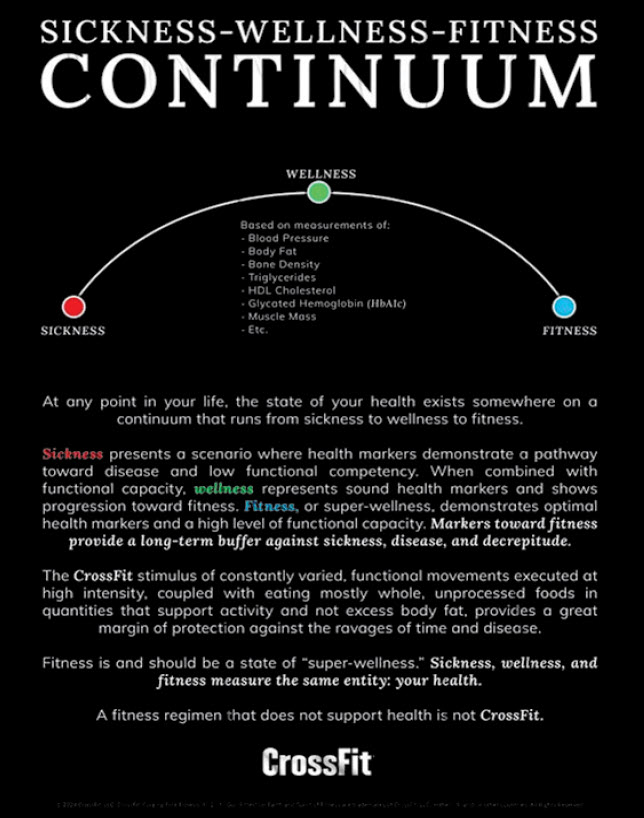The sickness-wellness-fitness continuum is a conceptual model that illustrates the spectrum of human health. It ranges from sickness through wellness to optimal fitness, emphasizing that fitness is not just about being well but represents an elevated state of health. This model is particularly relevant in the context of CrossFit, a fitness program that combines various elements of high-intensity interval training, weightlifting, and functional movements.
Understanding the Continuum
The continuum can be visualized as a straight line: Sickness — Wellness — Fitness
Sickness: This end of the spectrum represents poor health, characterized by chronic diseases, obesity, lack of physical activity, and overall poor quality of life. Individuals in this state often require medical intervention to manage their conditions.
Wellness: The middle of the continuum represents a state of being free from disease and maintaining basic physical and mental health. People in this category might engage in regular exercise and eat a balanced diet but may not be pushing themselves to achieve peak physical fitness.
Fitness: At this end of the continuum lies optimal health and performance. Individuals here have not only avoided sickness but have enhanced their physical capabilities. This state is marked by increased strength, endurance, flexibility, and a robust immune system. They are less likely to succumb to illness and recover more quickly when they do.
CrossFit and the Continuum
CrossFit positions itself as a pathway to move individuals along this continuum from sickness toward fitness. The program’s philosophy emphasizes the development of functional fitness through varied, high-intensity workouts. This approach is designed not only to enhance physical abilities but also to improve overall health markers.
Functional Movements: CrossFit workouts focus on functional movements, which are natural, multi-joint exercises like squats, deadlifts, and overhead presses. These movements mirror activities in daily life, promoting better overall body mechanics and reducing the risk of injury.
High Intensity: The high-intensity aspect of CrossFit workouts is a key factor in driving fitness gains. This intensity helps to increase cardiovascular fitness, burn fat, and build muscle, pushing participants towards the fitness end of the continuum.
Community and Support: CrossFit gyms, known as “boxes,” foster a sense of community. This support system encourages individuals to consistently engage in workouts, stay motivated, and adhere to healthier lifestyle choices, all of which contribute to moving along the continuum.
The Broader Implications
Adopting a CrossFit regimen can have profound effects beyond physical fitness. The program often leads to improvements in mental health, such as reduced stress, better mood, and increased resilience. The focus on measurable progress (through tracking personal records and improvements) helps individuals see tangible results, reinforcing positive behaviors.
The sickness-wellness-fitness continuum serves as a useful model for understanding health as a dynamic state that can be influenced by lifestyle choices. CrossFit, with its emphasis on functional movements, high-intensity workouts, and community support, offers a powerful approach to advancing along this continuum. By striving for fitness rather than merely avoiding sickness, individuals can achieve a higher quality of life, marked by enhanced physical capabilities, mental well-being, and a greater capacity to enjoy everyday activities.
By: Nick Niedzwiecki – Owner, CrossFit Athens







